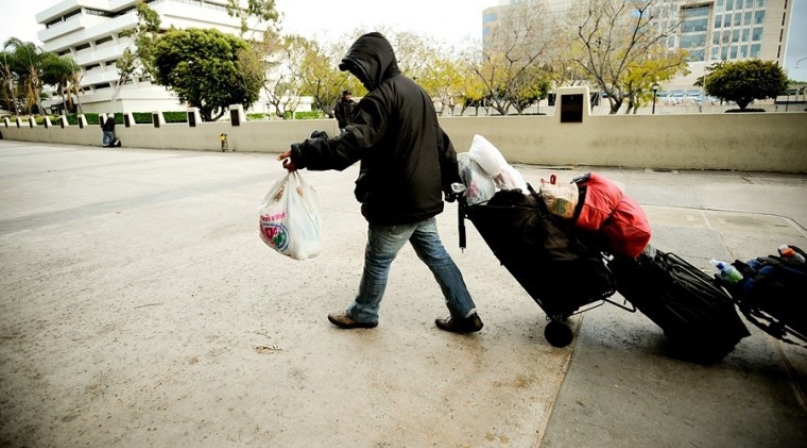Q & A with homeless advocate Nan Roman
Author

Ms. Nan Roman
Upcoming Events
Related News

Nan Roman is the president and CEO of the National Alliance to End Homelessness, a non-partisan, nationwide federation of public, private and nonprofit organizations with a network of more than 10,000 partners devoted to ending homelessness. To learn more, visit www.endhomelessness.org.
There seem to be several definitions of homelessness. How would you define it?
The National Alliance to End Homelessness generally uses the definition established by the departments of Housing and Urban Development and Veterans Affairs which states that an individual is homeless if he or she lives in an emergency shelter, transitional housing program, safe haven, or a place not meant for human habitation, such as a car, abandoned buildings or on the street.
It also includes people who are staying temporarily with someone else (doubled-up, couch-surfing) but have to leave imminently. We use definitions from other departments when they are relevant to their programs or for general information, but most often we focus on the HUD-VA definition.
Has the face of homelessness changed over the past 20 years?
There have been some changes in the various subpopulations in the past 20 years. Chronic homelessness — long-term homelessness among people with disabilities — has gone down. Veteran homelessness has gone down. This is due to concentrated efforts to attack these problems, ramped-up resources and tremendous innovation at the local level.
Although homelessness is a complicated problem — low incomes, high housing costs, disability, domestic violence, family conflict, health, and so many other factors play a role — it is important to remember that people who have a home are not homeless. Our work at the alliance is all about identifying and sharing strategies that will bring us, as a nation, closer to this simple solution of getting people into housing and ending their homelessness.
Do different populations — veterans, women, victims of domestic violence, for example — have different housing needs?
Different populations may need different types of housing interventions or different levels of housing assistance. For example, people with serious disabilities who are homeless for long periods of time need longer-term rental assistance, whereas many families and individuals who are homeless briefly for economic reasons may only need short-term help paying for housing.
Youth who are homeless might benefit from “host homes,” in which they live with a family; while survivors of domestic violence may require a safe and confidential place to stay in the short run and possible help relocating to housing in a different jurisdiction.
And although housing does end homelessness for everyone, many people also need services to stabilize their housing. Families may need home visiting and child care support. Veterans may need treatment or employment assistance. People with illness need connection to treatment and support.
What’s the most surprising fact about homelessness?
I don’t know about surprising but something that most people may not know is that we know how to end homelessness. We know what programs work to get people back into housing. For veterans, where investments for housing have been greater, dozens of places have already ended homelessness, using this know-how.
Another fact people may not recognize is that widespread homelessness hasn’t always been a problem in our country. Before the 1980s, homelessness was infrequent and usually very brief. When a family or individual experienced a crisis and lost their housing, they could quickly find another place to live: communities had enough affordable housing available for rent. Today, the supply of affordable housing is dwindling. Runaway rent increases are far outpacing the slow, stagnant growth in wages and the distance between the two is growing into a worrisome gap that is threatening the housing stability of more and more Americans.
What federal policies — if any — hamper efforts to serve the homeless population?
The major federal policy that affects homelessness is the lack of affordable housing. The federal housing support programs for low-income people do not receive nearly enough money — they are only available to about one-quarter of the people who need them, and the rest go without. Homeless people may have all sorts of problems, but if they are housed they are no longer homeless.
The market does not create or provide housing that is affordable to people who are poor — living at 30 percent of the area median income or below — in any community in the U.S. This results in too many people spending well over half of their incomes for rent. Any crisis — the loss of a job, an illness, a move away from their support system — can catapult them into homelessness. Three times more people need housing assistance than get it, and this failure to support people causes too many to become homeless.
Is it likely there will always be some percentage of the population who chose to remain unsheltered?
In some places, the number of unsheltered homeless is expanding rapidly. On a single night in January 2016, there were 176,357 people living outside. That is an increase of nearly 2 percent from last year. There are a lot of factors that go into that number. Some of these individuals do choose to live outside and remain outside of the system. For others, it’s the only option if they choose to not seek temporary emergency shelter — and that’s a choice that they could be making based on a variety of factors. And in some communities there is not nearly enough capacity to shelter all homeless people.
Every day, in cities across the nation, there are outreach workers who go out into communities and encourage people on the street to come inside but many refuse. For some, avoiding shelters is related to a mental illness, for others it might be well-founded fear, since shelters are not always safe places.
High barriers to access a shelter can also be a deterrent. These barriers are requirements that must be met in order to utilize services — requirements like sobriety, a curfew or even having a photo ID. In some cases for families, being unsheltered might be the only option if they want to stay together or don’t want to leave a pet behind.
These are all factors that play into the unsheltered number but are also factors we can mitigate in order to help the most people possible.
What’s the biggest myth about the homeless?
There are several assumptions that people make about homelessness that turn out not to be true.
One myth is that homeless people are all single adults who are homeless for years on end and live in shelters or sleep on the streets. There are certainly some people who fit that description, most of whom have severe disabilities that require treatment. But nearly a third of people who are homeless live in families; and most single adults are homeless only briefly before getting back into housing.
Another myth is that before homeless people can get back into housing they need to resolve any problems they may have. If they’re unemployed, they need to get a job. If they have a substance abuse disorder they need to get clean and sober. If they have a mental illness, they need to complete treatment. In fact, it turns out that it is very difficult for people to resolve very difficult problems like these when they are living on the streets on in shelters. On the other hand, having a stable home allows people to take on and address these complex issues. All of us need the safety of a home to successfully address life’s problems.
While federal, state and local governments all grapple with the problem of homelessness, whom do you believe has the largest stake in solving it?
I am not sure that any one level of government has a greater stake than the others, but because homelessness is experienced at the local level, it is likely that’s where not only the economic costs but also the social and human toll of the problem is most directly felt.
People point to poverty, lack of affordable housing, domestic violence, unemployment, substance abuse problems or mental health issues as the principal causes of homelessness. Would you agree, and if so, which do you think is the most likely reason?
Many factors contribute to homelessness: poverty, mental illness, addictive disorders, decreases in public assistance, rising health care costs. But the main reason people experience homelessness is because they cannot afford the housing that is available to them. Runaway rent increases are far outpacing the slow, stagnant growth in wages and the distance between the two is growing into a worrisome gap.
What advice would you give county leaders seeking to reduce the number of homeless in their communities?
I would advise three things: commit to ending homelessness, set a timeline for getting there and put together the partners you need to solve the problem; focus on the strategies that are proven to work with an emphasis on housing; and remember that although we know what to do, we need to do enough of it and do it long enough to reach the goal.
Attachments
Related News
Stretching small opioid settlement allocations helps funding do more
States and localities are set to receive $56 billion in opioid settlement dollars over an 18-year period, but not every county that receives settlement funding will get enough to build out infrastructure.

